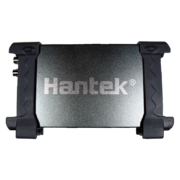Hantek 6022BE
 | |
| Status | supported |
|---|---|
| Source code | hantek-6xxx |
| Channels | 2 |
| Samplerate | 48MHz |
| Analog bandwidth | 20MHz |
| Vertical resolution | 8bit |
| Triggers | none (SW-only) |
| Input impedance | 1MΩ‖25pF |
| Memory | none |
| Display | none |
| Connectivity | USB |
| Website | hantek.com |
The Hantek 6022BE is a USB-based, 2-channel oscilloscope with an analog bandwidth of 20MS/s and 48MS/s sampling rate.
See Hantek 6022BE/Info for more details (such as lsusb -v output) about the device.
Hardware
- USB: Cypress CY7C68013A-100AXC (FX2LP) (datasheet)
- 256-byte I²C EEPROM: Microchip 24LC02BI (datasheet)
- 2x 8-channel analog multiplexer/demultiplexer: NXP 74HC4051D (datasheet)
- 1A low-dropout voltage regulator (3.3V): Advanced Monolithic Systems AMS1117-3.3 (datasheet)
- 2W, fixed input, isolated & unregulated dual/single output DC/DC converter: Mornsun A_S-2WR2 (A0505S-2WR2) (datasheet)
- 8-bit, 40/80/100MHz, dual ADC: Analog Devices AD9288 (datasheet)
- 4x 145 MHz FastFET Op Amp: Analog Devices AD8065 (datasheet)
- Crystal: 24MHz
NXP 74HC4051D (upper/lower, CH1/CH2) pinout:
|
|
| S2 | S1 | S0 | 74HC4051D Mux | VDIVs (vendor software) |
|---|---|---|---|---|
| 0 | 0 | 0 | Y0 to Z | 200mV |
| 0 | 0 | 1 | Y1 to Z | 500mV |
| 0 | 1 | 0 | Y2 to Z | 5V, 2V, 1V |
| 0 | 1 | 1 | Y3 to Z | 100mV, 50mV, 20mV |
Microchip 24LC02BI pinout:
| (Low, but not GND) A0 | 1- | O | -8 | VCC |
| (GND) A1 | 2- | -7 | WP (GND) | |
| (GND) A2 | 3- | -6 | SCL (FX2 SCL) | |
| VSS | 4- | -5 | SDA (FX2 SDA) |
Analog Devices ADS9288 pinout:
| AD9288 pins | Description |
|---|---|
| S1, S2 | S1=VCC, S2=GND. "Normal operation, data align disabled". |
| DFS | Tied to GND. Data format select = "offset binary" (not "twos complement"). |
| AINA, AINB | Analog input channels. |
Cypress FX2 pinout:
| FX2 pins | Description | |||||||||||||||
|---|---|---|---|---|---|---|---|---|---|---|---|---|---|---|---|---|
| CTL2 | Connected to AD9288 ENCA and ENCB and FX2 IFCLK. | |||||||||||||||
| PB0-PB7 | Connected to AD9288 D0A-D7A. | |||||||||||||||
| PD0-PD7 | Connected to AD9288 D0B-D7B. | |||||||||||||||
| PA7 | 1kHz probe calibration pin. | |||||||||||||||
| PC0/PC1 | Dual-color (red/green) LED.
|
Photos
Another teardown:
Protocol
| Oscilloscope command | bRequest value | Notes |
|---|---|---|
| Set CH0 voltage range | 0xE0 | Possible values: 1, 2, 5, 10 (5V, 2.5V, 1V, 500mV). |
| Set CH1 voltage range | 0xE1 | Possible values: 1, 2, 5, 10 (5V, 2.5V, 1V, 500mV). |
| Set sampling rate | 0xE2 | Possible values: 48, 30, 24, 16, 8, 4, 1 (MHz) and 50, 20, 10 (*10kHz). |
| Trigger oscilloscope | 0xE3 | Possible values: 1 == start sampling. 0 == ignored currently. |
| Set number of channels | 0xE4 | Possible values: 1, 2. |
Firmware
In order to use this device, the sigrok-firmware-fx2lafw (>= 0.1.4) firmware is required.
The firmware was originally written by Jochen Hoenicke (see README for details), thanks a lot!
Note: The firmware is not flashed into the device permanently! You only need to make it available in the usual place where libsigrok looks for firmware files, it will be used automatically (and "uploaded" to the Cypress FX2's SRAM every time you attach the device to a USB port).
Note: On Windows, you will have to assign the WinUSB driver via Zadig twice: the first time for the initial USB VID/PID the device has when attaching it via USB (04b4:6022 or 04b5:6022, depending on which vendor driver is currently being used by the device), and a second time after the firmware has been uploaded to the device and the device has "renumerated" with a different VID/PID pair (1d50:608e).
Example sigrok-cli commands
Example sigrok-cli commands for the Hantek 6022BE. See sigrok-cli for a full list of available commands.
Display the capabilities of the device attached
sigrok-cli --driver hantek-6xxx --show
To show the options of the channel group "CH1"
sigrok-cli --driver hantek-6xxx --channel-group CH1 --show
Example for collecting 100 samples at 1MHz
sigrok-cli --driver hantek-6xxx --config samplerate=1m --samples 100
For collecting samples for 100 ms
sigrok-cli --driver hantek-6xxx --time 100
For collecting 20k samples at 1MHz sample rate and save to a csv file in the sigrok-cli directory. May require admin rights depending on sigrok-cli install location.
sigrok-cli --driver hantek-6xxx --config samplerate=1m --output-file test.csv --output-format csv --samples 20k
Note: sigrok-cli can only be used with one Hantek 6022BE device at a time.



















